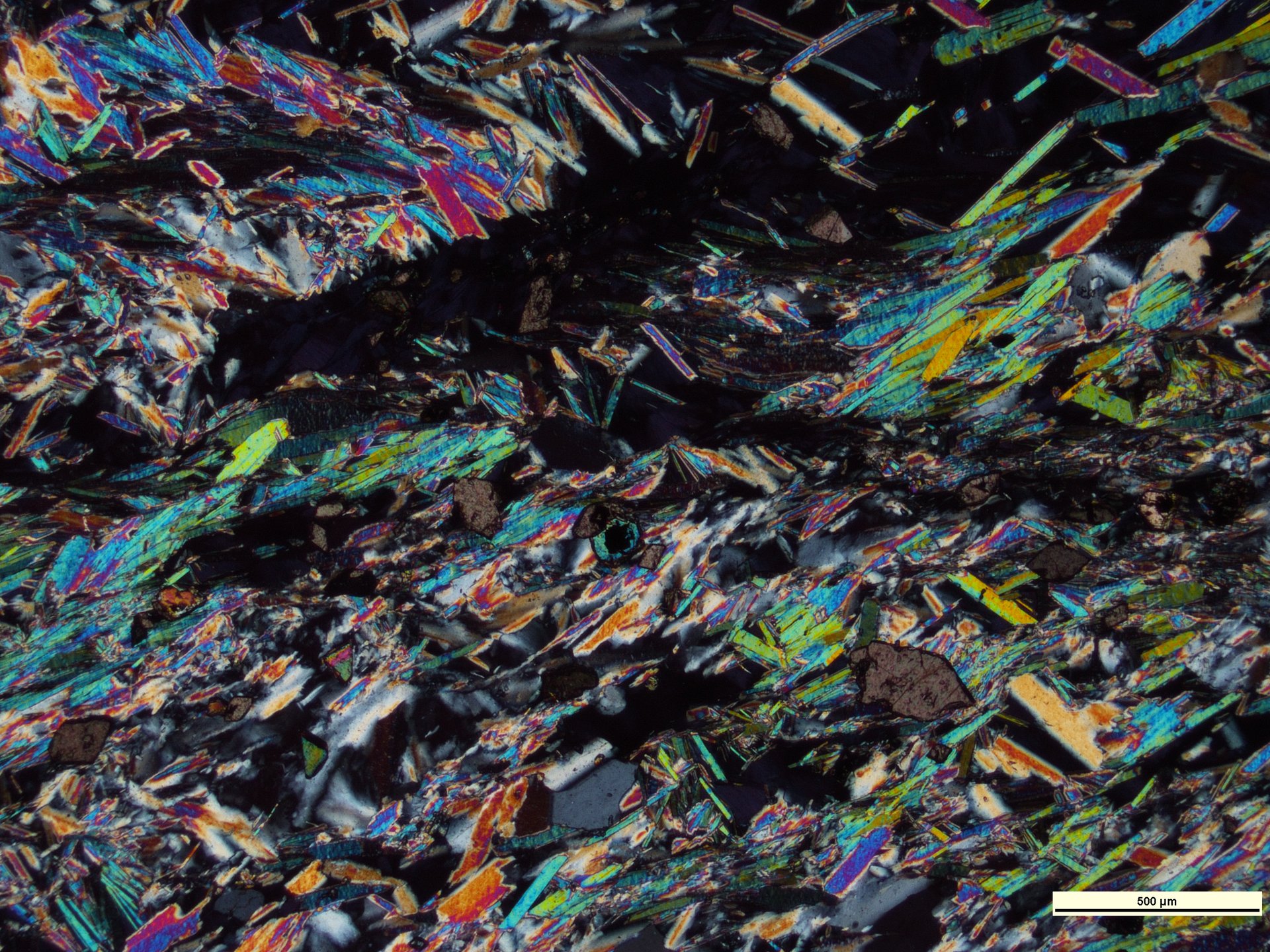
Dewangga, D.D., Tsai, C.H., Iizuka, Y., Sakaguchi, I.T., Kouketsu, Y., Chung, S.L., Lee, C.Y., Chang, W.Y., and Chen, H.F. (2025) Origins and metamorphism of ophiolitic serpentinites from the Yuli belt, eastern Taiwan: new findings and tectonic implications. International Geology Review 67(7), 933–949. https://doi.org/10.1080/00206814.2024.2415088 See abstract
Dewangga, D.D., Tsai, C.H., Lee, H.Y., Iizuka, Y., Chung, S.L., and Chang, W.Y. (2025) Element redistributions along the subduction interface: a case study of metasomatism between pelitic schist and ophiolitic serpentinite in the Yuli belt, eastern Taiwan. Lithos 516-517, 108280. https://doi.org/10.1016/j.lithos.2025.108280 See abstract
Dewangga, D.D., Lo, W.H., Tsai, C.H., Kouketsu, Y., Iizuka, Y., and Lee, H.Y. (2026) Subduction metamorphism recorded in metasomatic zones from the Yuli belt, eastern Taiwan: metamorphic conditions and tectonic implications. in prep.
Dewangga, D.D., Tsai, C.H., Wang, K.L., Lee, H.Y., and Kourim, F. (2026) Geochemical features of serpentinites in an exhumed subduction complex: serpentinizing fluid source and tectonic setting. in prep.
Publications
Conferences
Dewangga, D.D., Lo, W.H., Tsai, C.H., Kouketsu, Y., Iizuka, Y., and Lee, H.Y. (2025) Amphibole-albite rock in a metasomatic zone: a record of subduction metamorphism at the slab-mantle interface and its tectonic implications. Japan Geoscience Union (JpGU) Annual Meeting 2025. Chiba, Japan. See details
Dewangga, D.D., Tsai, C.H., Lee, H.Y., Iizuka, Y., Lo, W.H., Chung, S.L., and Chang, W.Y. (2023) Mass transfer between serpentinites and metapelites in a paleo-subduction interface: a case study from the Yuli belt, eastern Taiwan. US-Taiwan Conference 2023. Taipei, Taiwan. See details
Tsai. C.H., Lo, W.H., Dewangga, D.D., Yeh, C.Y., Kuo, L.W., and Iizuka, Y. (2023) Petrographic characterization of some metamorphic rocks from MiDAS drill core samples: a preliminary report. Geological Society of Taiwan (GST) Annual Meeting 2023. Hualien, Taiwan.
Dewangga, D.D., Tsai, C.H., Iizuka, Y., Sakaguchi, I.T., Kouketsu, Y., Chung, S.L., Chang, W.Y., and Chen, H.F. (2023) Deciphering the mysteries in serpentinies from the Yuli belt: origins and metamorphic conditions. Taiwan-Philippines Conference 2023. Tainan, Taiwan. See details
Dewangga, D.D., Tsai, C.H., Lee, H.Y., Lo, W.H., Iizuka, Y., and Lee, C.Y. (2023) Mass transfer between serpentinites and metapelites in a paleo-subduction interface: a case study from the Yuli belt, eastern Taiwan. European Geosciences Union (EGU) General Assembly 2023. Vienna, Austria. See details
Lo, W.H., Tsai, W.H., and Dewangga, D.D. (2023) On the peak metamorphic conditions of the Yuli belt, eastern Taiwan: new constraints using garnet isopleths. European Geosciences Union (EGU) General Assembly 2023. Vienna, Austria.
Dewangga, D.D., Tsai, C.H., Lo, W.H., Lee, H.Y., Iizuka, Y., and Kouketsu, Y. (2022) High-pressure rocks within metasomatic zones in the Yuli belt, eastern Taiwan: metamorphic conditions and tectonic implications. Taiwan Geosciences Assembly (TGA) 2022. Taipei, Taiwan.
Dewangga, D.D., Tsai, C.H., Lee, H.Y., and Iizuka, Y. (2022) Fluid-rock interaction during subduction metamorphism: a case study on metasomatic rocks from the Yuli belt, eastern Taiwan. Taiwan Geosciences Assembly (TGA) 2022. Taipei, Taiwan.
Dewangga, D.D., Tsai, C.H., Iizuka, Y., and Kouketsu, Y. (2022) Subduction metamorphism recorded in metasomatic rocks from the Yuli belt, eastern Taiwan: metamorphic conditions and tectonic implications. Japan Geoscience Union (JpGU) Annual Meeting 2022. Chiba, Japan. See details
Sakaguchi, I.T., Kouketsu, Y., Dewangga, D.D., Tsai, C.H., and Michibayashi, K. (2022) Evidence for active subduction zone fluid flow recorded in antigorite serpentinites in the high-P metamorphic Yuli belt, eastern Taiwan. Japan Geoscience Union (JpGU) Annual Meeting 2022. Chiba, Japan.
Dewangga, D.D., Tsai, C.H., Lee, H.Y., Iizuka, Y., Lo, W.H., and Lee, C.Y. (2022) Metasomatism between serpentinite and pelitic schist in the Yuli belt, eastern Taiwan: fluid-rock interactions during subduction metamorphism. European Geosciences Union (EGU) General Assembly 2022. Vienna, Austria.
Dewangga, D.D., Tsai, C.H., Iizuka, Y., Kouketsu, Y., Sakaguchi, I.T., Chung, S.L., and Chen, H.F. (2021) Reinterpreting Yuli belt serpentinites in eastern Taiwan. Geological Society of Taiwan (GST) Annual Meeting. Taipei, Taiwan.
Sakaguchi, I.T., Kouketsu, Y., Dewangga, D.D., Tsai, C.H., and Michibayashi, K. (2020) The microstructure and composition of picrolitic antigorite veins in serpentinites from the high pressure metamorphic Yuli belt in eastern Taiwan. Japan Geoscience Union–American Geophysical Union (JpGU-AGU) Annual Meeting. Chiba, Japan.
Dewangga, D.D., Tsai, C.H., Iizuka, Y., Yeh, C.Y., and Kouketsu, Y. (2019) A new discovery of sodic-amphibole in metasomatic zones around serpentinite, Yuli Belt, Eastern Taiwan: metamorphic conditions and tectonic implications. Asia Oceania Geoscience Society (AOGS) Annual Meeting. Singapore.
Tsai, C.H., Yeh, C.Y., Dewangga, D.D., Kouketsu, Y., and Masaki, E. (2019) New petrologic indications of subduction metamorphism in the Yuli belt, eastern Taiwan. Japan Geoscience Union–American Geophysical Union (JpGU-AGU) Annual Meeting. Chiba, Japan.
Dewangga, D.D., Tsai, C.H., Lo, W. H., and Iizuka, Y. (2018) Relict Cr-spinel compositions and their geologic implications of the Yuli belt serpentinites, eastern Taiwan. Geological Society of Taiwan (GST) Annual Meeting. Chiyai, Taiwan.
Dewangga, D.D., Tsai, C.H., Lo, W. H., and Iizuka, Y. (2018) Relict chromian spinels in serpentinites of the Yuli belt, eastern Taiwan: compositional characteristics and geologic implications. Japan Geoscience Union–American Geophysical Union (JpGU-AGU) Annual Meeting. Chiba, Japan.
Tsai, C.H., Liu, C., Lo, W.H., Keyser, W., Yeh, C. Y., and Dewangga, D.D. (2017) On the high-pressure tectonic blocks in the Yuli belt, eastern Taiwan: petrological characterization and implications. Geological Society of Taiwan (GST) Annual Meeting 2017. Tainan, Taiwan.
Element redistributions along the subduction interface: a case study of metasomatism between pelitic schist and ophiolitic serpentinite in the Yuli belt, eastern Taiwan.
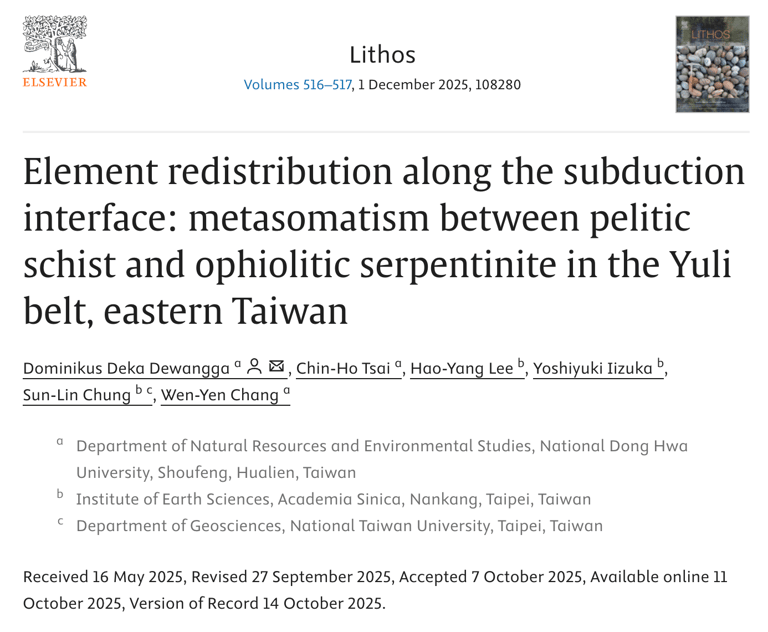

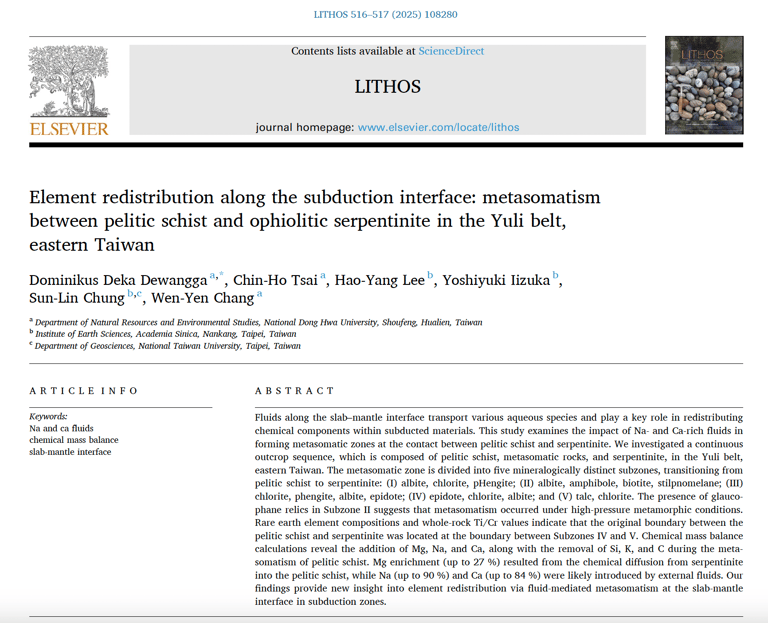

Previous research
Origins and metamorphism of ophiolitic serpentinites from the Yuli belt, eastern Taiwan: new findings and tectonic implications
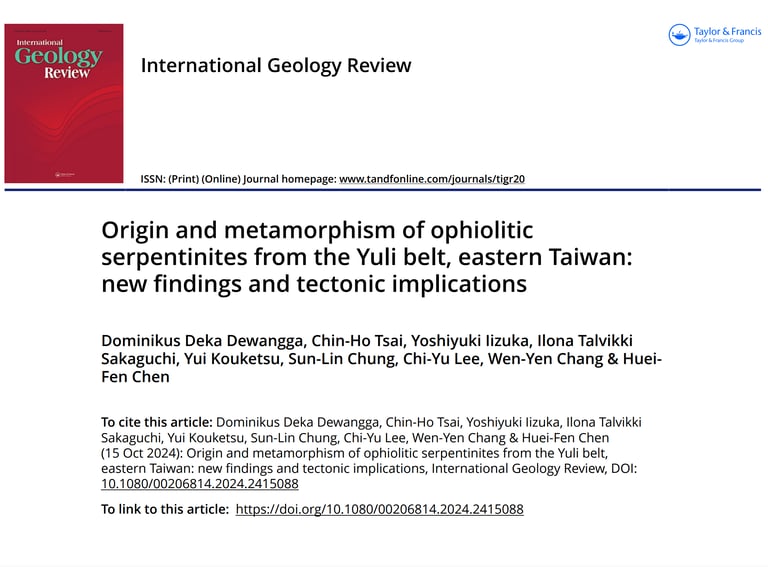

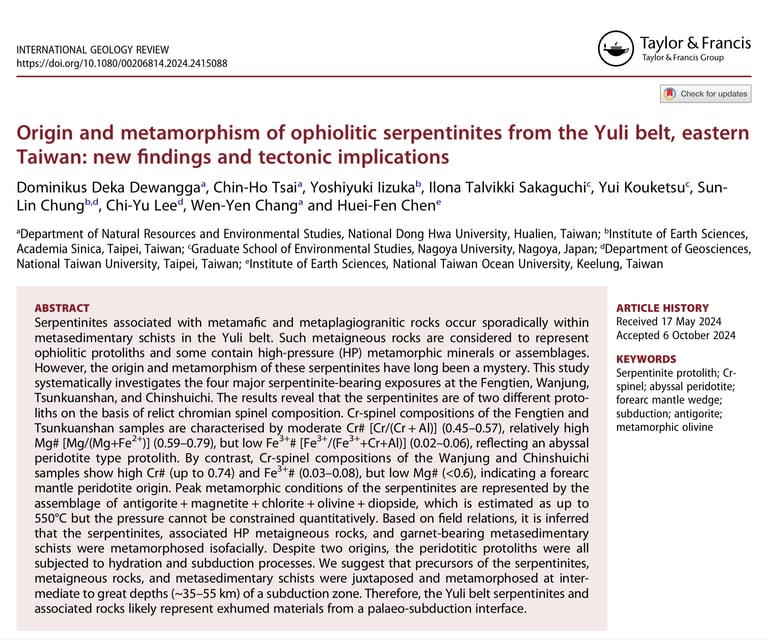

Amphibole-albite rock in a metasomatic zone: a record of subduction metamorphism at the slab-mantle interface and its tectonic implications
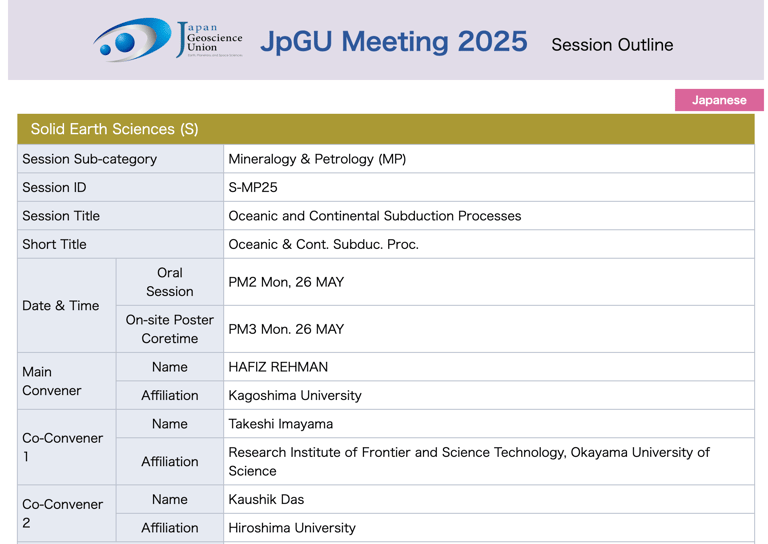

An oral presentation at the Japan Geoscience Union (JpGU) Annual Meeting 2025 located in Chiba, Japan.
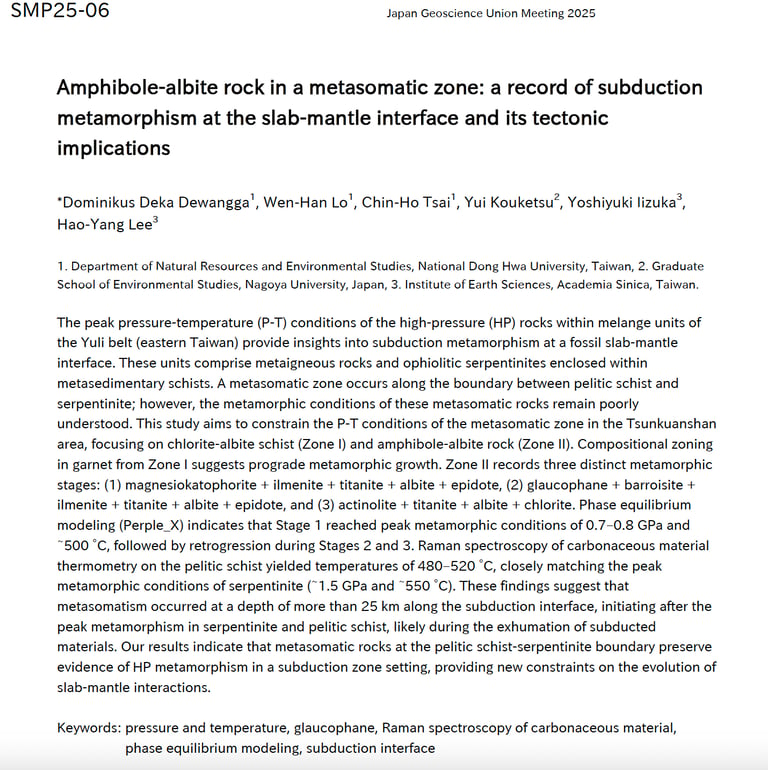

Mass transfer between serpentinites and metapelites in a paleo-subduction interface: a case study from the Yuli belt, eastern Taiwan
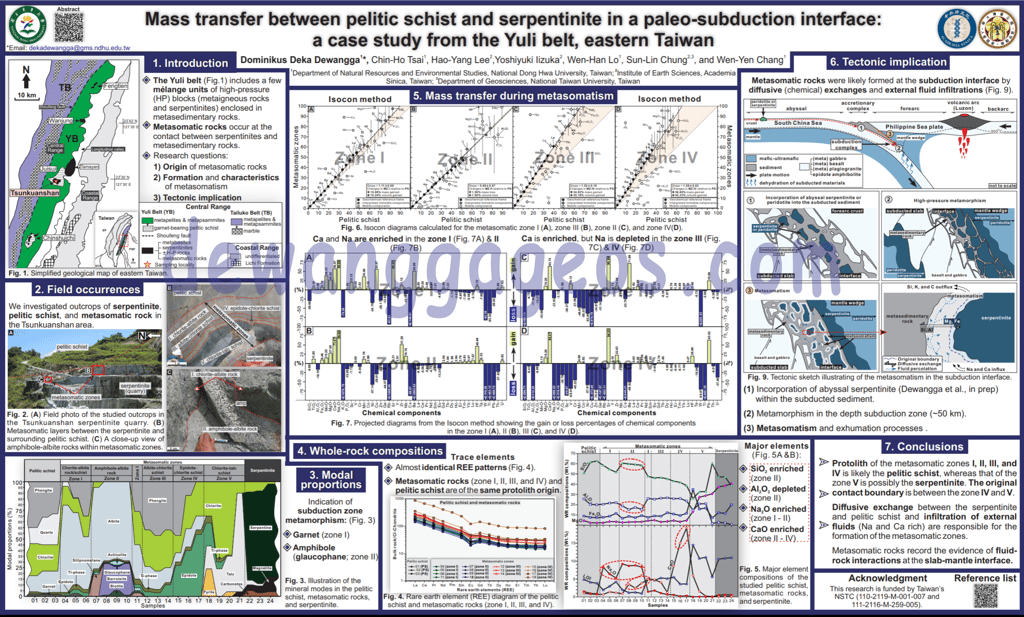

Presented at the US-Taiwan International Conference 2024 located in the Institute of Earth Sciences, Academia Sinica, Taiwan.
The Yuli belt in eastern Taiwan attests to tectonic evolution involving subduction metamorphism because two metamélange units contain high-pressure blocks or layers of metaigneous rocks and serpentinites enclosed in metasedimentary schists. Metasomatic reaction zones occur locally along the contact between serpentinite and pelitic schist. In this research, we showed that the formation of these metasomatic rocks was not only controlled by diffusive exchanges between pelitic schist and serpentinite, but also by the Na and Ca rich fluid infiltrations. The existence of glaucophane indicates that the metasomatism occurred under high-pressure metamorphic conditions in a paleo-subduction interface.
Deciphering the mysteries in serpentinies from the Yuli belt: origins and metamorphic conditions
This research was presented at the Taiwan-Philippines Conference 2023 located at the National Cheng Kung University in Tainan, Taiwan.
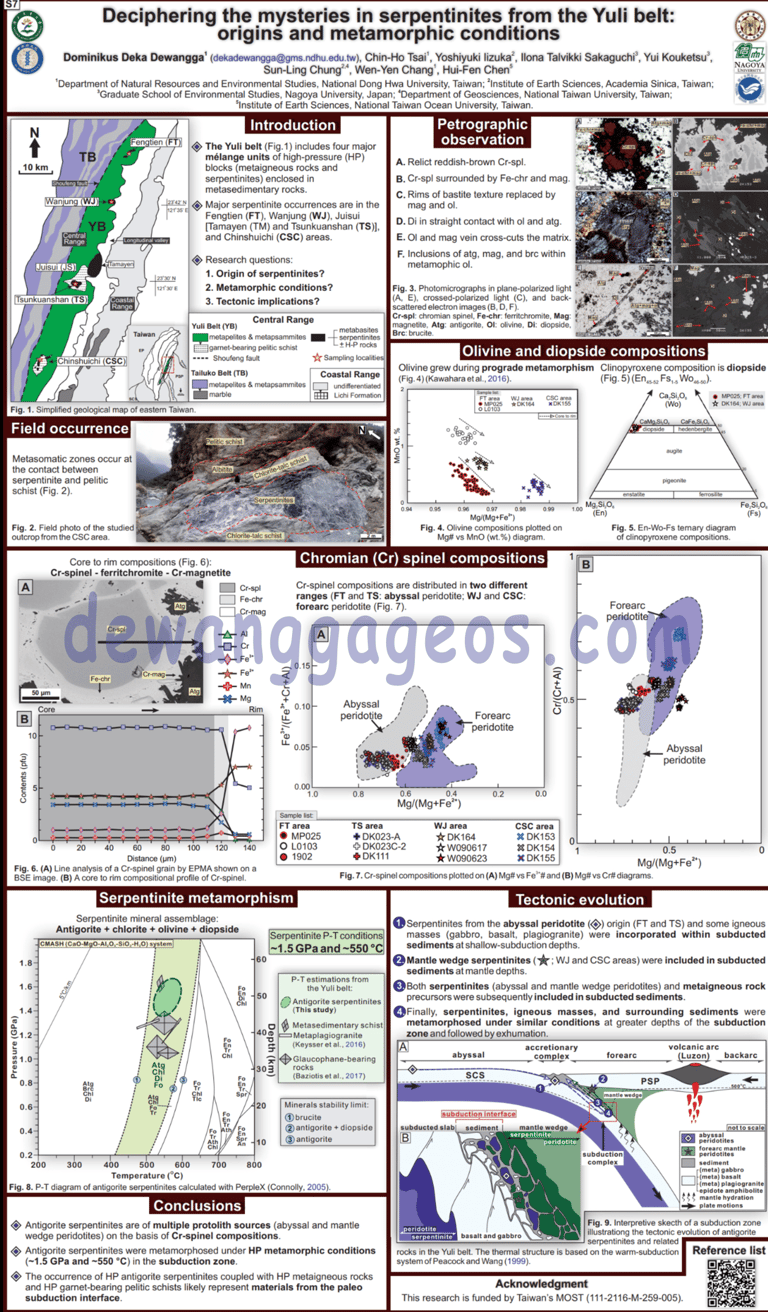

Serpentinites and associated meta-igneous to meta-volcaniclastic rocks occur sporadically as exotic blocks or layers within metasedimentary schists in the Yuli belt. Some of the meta-igneous/-volcaniclastic rocks contains high-pressure minerals, such as glaucophane or omphacite. These predominantly-mafic/ultramafic rocks are generally interpreted as metamorphosed ophiolitic fragments. However, origin and metamorphism of the serpentinites have long been enigmatic. This study investigates serpentinites from the Fengtien (FT), Wanjung (WJ), Tsunkuanshan (TS), and Chinshuichi (CSC) areas. Based on Cr-spinel composition, protoliths of these serpentinites are distinctively differentiated into two origins. Cr-spinel relics in the FT and TS areas are characterized by moderate Cr# (0.45-0.57), relatively high Mg# (0.59-0.79), but low Fe3+# (< 0.02), suggesting an abyssal peridotite origin. By contrast, the WJ and CSC serpentinites are likely of forearc mantle peridotite origin because of the high Cr# (up to 0.74) and Fe3+# (0.02-0.08), but low Mg# (< 0.6) in their relict Cr-spinel compositions. The peak metamorphic assemblage of the serpentinites is antigorite + magnetite + chlorite + olivine + diopside, indicating a metamorphic temperature around 550 °C. Serpentinites, meta-igneous rocks, and surrounding metasedimentary schists were likely metamorphosed at similar conditions (~1.5 GPa; ~550 °C), i.e. at great depths (~50 km) of a paleo-subduction zone. The Yuli belt serpentinites and associated rocks may represent exhumed materials from the subduction interface.
Mass transfer between serpentinites and metapelites in a paleo-subduction interface: a case study from the Yuli belt, eastern Taiwan
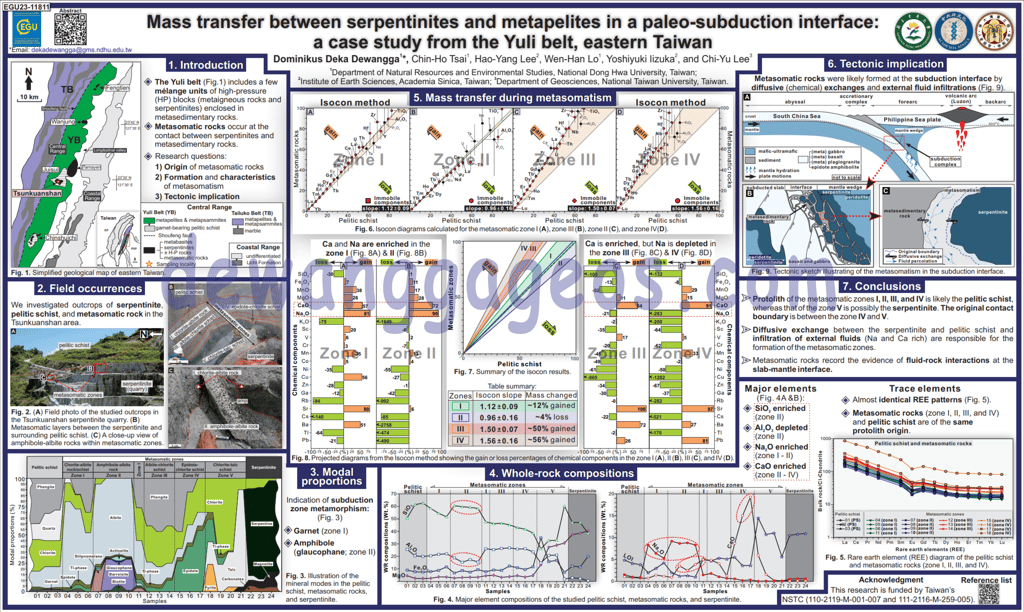

I presented this research finding at the European Geosciences Union (2023) Annual Meeting located in Vienna, Austria.
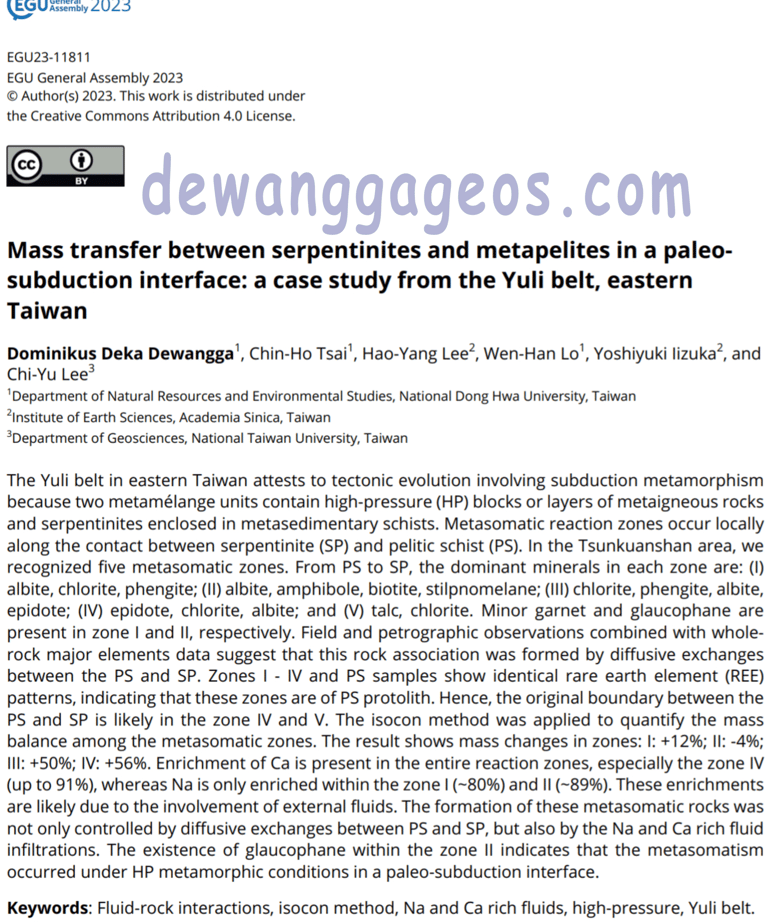

Subduction metamorphism recorded in metasomatic rocks from the Yuli belt, eastern Taiwan: metamorphic conditions and tectonic implications
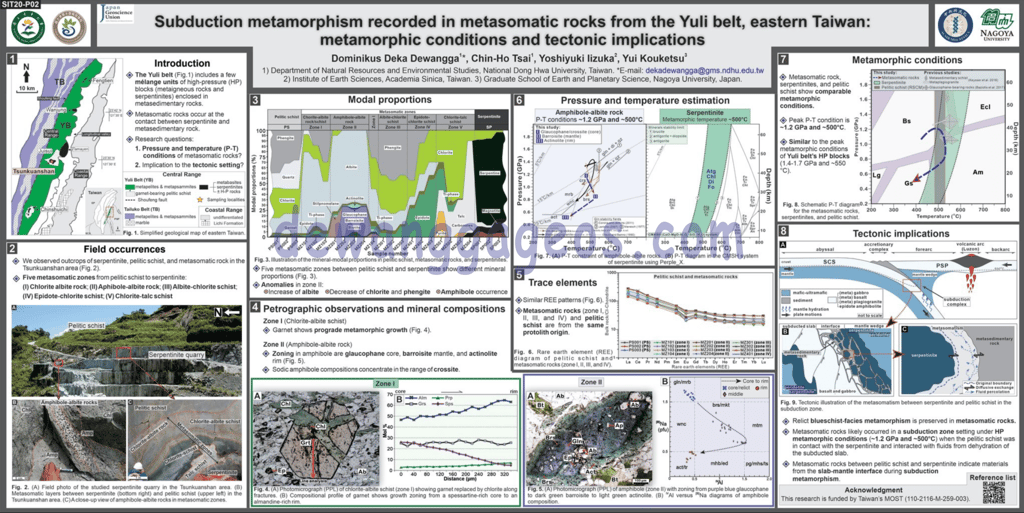

I presented this research finding at the Japan Geosciences Union International Conference on May 2022. This conference was located in Chiba, Japan.
We estimate metamorphic conditions of the metasomatic rocks on the basis of the mineral assemblages and compositions with the temperature constrained by Raman spectroscopy of carbonaceous material (RSCM) thermometry and pseudosection modeling (Perple_X). The peak metamorphic conditions of metasomatic rocks are ~1.2 GPa and ~500 °C. This result indicates that relict blueschist-facies metamorphism is preserved in the zone I and II, whereas the zone III-V might have been overprinted by retrograde greenschist-facies metamorphism. The RSCM thermometry on the PS yielded a temperature range of 480-520°C. Pseudosection modeling of the SP resulted in a possible peak metamorphic temperature around 500-550 °C. These pressure and temperature estimations imply subduction metamorphism and are similar to the peak metamorphic conditions of Yuli belt’s HP blocks (1.4-1.7 GPa and ~550 °C). We interpret that metasomatic rocks between PS and SP were formed during subduction metamorphism followed by exhumation processes along the subduction interface.
Contacts
dekadewangga@gms.ndhu.edu.tw
Social media
(+886)-3-8905177 (Lab)
@dekadewangga
Department of Natural Resources and Environmental Studies, National Dong Hwa University. No. 1, Sec. 2, Da Hsueh Rd., Shoufeng, Hualien 97401, Taiwan, R.O.C.
